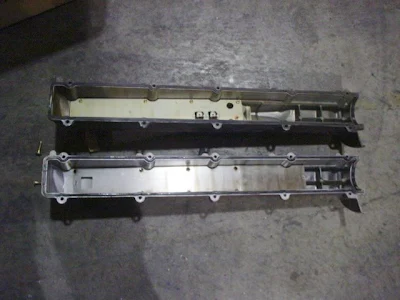Cam cover to rear turbo inlet hose- left side
11826-24U10
 |
| Stock R34 PCV |
Oily air sucked and burned in the engine, lowers the effective octane of fuel. It also coats the inside of the inlet manifold, intercooler piping,etc, and can end up with deposits on the valves. So, what happens if you just take all that "junk" off, and just put a breather on? Well under vacuum, air will enter the engine through the breather. No big deal. No problems normally. However under boost, air from inside the engine, will try and move out of the engine. This would be no problem if it were just air, but its not. It has oil suspended in the air. So even with a breather filter on the engine, you will have oily air come out the breather. This oily air will get all over your engine compartment. For one it creates a big mess. For two it is flammable.
An RB moves a lot of oily air around. With combustion pressure leaking by the rings (totally normal in moderate amounts) the crank is pressurized. The higher you boost, the more power you make, the higher you rev, the more oily air you are going to have. Then the RB26 have oil squirters to cool the pistons. These oil squirters whip up a ton of oily air.
What to do? Catchcan. Now there are some best practices. There are some odd things we have seen through the years. There are a ton of places that make catchcans. Some designs are good, some are awful. Some designs I have seen, that will never ever have oil come in them, because they have been setup wrong.
 |
| Racecar parts. Catchcan that collects oil vapors, and returns to sump. |
1) The oily air,
has to want to move to the catch can. You can not put an enclosed catchcan, aka no vent, at the end of some hoses, and expect much to happen. It might capture some oil, but in the end, why does the oily air want to travel to it?
2) Returning caught oil to the sump. Some people don't like the idea of it. Knowing how much moves in an RB, I like the idea.
NISMO sells a catchcan that has a sump return. In the end, we replace oil fairly often, and as long as you get the oil warm every now and then, any water trapped in the oil, will want to burn off.
3) The R34 racecar, setup by Nismo had baffled cam covers, it had a small catchcan that returned to the sump, a larger overflow can, and then that can vented out the rear of the car. They were serious in making sure that the crankcase was properly vented. In the lead picture above, the rear vent isn't actually connected.
4) If the oily air stays in the cam cover, then it won't even make it to the catchcan.
Mines sells a foam insert/triple flow cam baffle plate. Not a huge fan of foam in the engine, as I think it can break down after a few years of use. I would change it out every year. In my other engine, I run the Reinik baffle plates. Reinik/Reimax built the Group A R32 GT-R engines, and they make some nice parts.
5) Other options, not seen too much in the import world. Pan-Evac, and vacuum pumps
- A Pan-Evac system connects the valve covers on both sides of the engine to the exhaust header collectors with one-way check valves and vent tubes that blend into the exhaust stream at approximately 45 degrees. Exiting exhaust gasses pull a vacuum on the tubes, thus drawing excess crankcase pressure from the sump and discharging it out the collector. This action relieves blow-by pressure under the rings, reducing windage and contamination. Although purely passive, the system proved remarkably efficient, and thousands of racers used them religiously until the emergence of modern external vacuum pumps.
- https://www.dragzine.com/tech-stories/tech-how-external-vacuum-pumps-free-up-horsepower/
 |
| Catchcan that returns to sump is visible under Nismo titanium strut tower brace |
 |
| Overflow catchcan, that is hooked to can that returns to sump. The other line vents out the rear of the car. |
Buy USA Legal R32 Skylines at Importavehicle.com!
Buy-R.com for Nissan Skyline GT-R and GT-R parts.























No comments:
Post a Comment